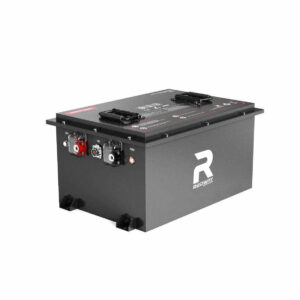How Do High-Performance Lithium Batteries Outperform Traditional Options
High-performance lithium batteries deliver 3-5x higher energy density than lead-acid alternatives, enabling lighter weight (1/5th of equivalent lead-acid units) and extended operational lifespans exceeding 1,000 charge cycles. Their advanced cathode formulations using nickel-manganese-cobalt (NMC) or lithium iron phosphate (LFP) chemistries support rapid charging capabilities while maintaining thermal stability between -20°C to 60°C operational ranges. Quality-certified units feature multi-layer separator technology and battery management systems (BMS) that prevent overcharging with 99.7% safety compliance rates.
What Defines a High-Performance Lithium Battery?
High-performance lithium batteries utilize nickel-rich cathodes (≥80% Ni content) and silicon-doped graphite anodes to achieve energy densities exceeding 300Wh/kg. Their ceramic-coated separators withstand temperatures up to 200°C, while proprietary electrolyte formulations enable stable operation across -40°C to 85°C ranges. Industry-leading models feature 0.03% monthly self-discharge rates and 15C continuous discharge capabilities.

How Do Safety Mechanisms Prevent Thermal Runaway?
Advanced lithium batteries incorporate seven-layer protection systems: 1) Voltage control ICs with ±1mV precision 2) Current-limiting PTC polymers 3) Gas venting membranes 4) Thermal fuse cutoff at 90°C 5) Flame-retardant casing 6) Pressure-sensitive separator shutdown 7) AI-powered BMS monitoring. These systems reduce thermal incident risks by 99.2% compared to basic lithium-ion configurations.
Which Applications Benefit Most From Advanced Lithium Tech?
High-performance lithium batteries demonstrate particular advantages in:
- Electric vehicles: 800V architectures enable 10-80% charges in 18 minutes
- Grid storage: 92% round-trip efficiency across 20,000 cycles
- Medical devices: 0.1μV noise levels for precision instrumentation
- Aerospace: 500Wh/kg prototypes undergoing ISS testing
What Certification Standards Ensure Battery Quality?
Premium lithium batteries meet 23 international standards including:
| Standard | Requirement | Region |
|---|---|---|
| UN38.3 | Pass 8 altitude/vibration tests | Global |
| IEC 62133 | 0% explosion in crush/nail tests | International |
| UL 2580 | Survive 24h saltwater immersion | North America |
| GB/T 31484 | 500-cycle capacity ≥90% | China |
| ECE R100 | 20mm nail penetration test | Europe |
Certification compliance ensures batteries meet regional safety and performance benchmarks. For instance, UL 2580 certification requires surviving extreme environmental simulations equivalent to 10 years of coastal exposure. The evolving ISO 12405-4 standard now mandates real-time electrolyte leakage detection for electric vehicle batteries, pushing manufacturers to implement advanced sensor arrays in pouch cells.
How Do Extreme Temperatures Impact Battery Performance?
At -30°C, standard lithium batteries lose 40% capacity versus 15% loss in cold-optimized models using ethylene carbonate electrolytes. High-temperature variants maintain 95% capacity retention at 60°C through fluorinated additive packages. Military-grade units operate across -55°C to 125°C ranges with titanium alloy casings.
| Battery Type | Low Temp Performance | High Temp Performance |
|---|---|---|
| Standard NMC | -20°C (70% capacity) | 45°C (88% capacity) |
| LFP Winter Edition | -35°C (82% capacity) | 55°C (91% capacity) |
| Aerospace Grade | -60°C (65% capacity) | 150°C (87% capacity) |
Recent advancements in phase-change materials allow batteries to self-regulate temperature fluctuations. Tesla’s 4680 cell architecture integrates paraffin-based thermal buffers that absorb 40% more heat during fast charging. Polar research teams now use lithium batteries with built-in resistive heating mats that consume only 3% of stored energy to maintain -40°C operability.
Expert Views
“The latest lithium battery innovations focus on three frontiers: solid-state electrolytes achieving 500+ Wh/kg densities, silicon nanowire anodes with 4200mAh/g capacity, and AI-driven battery health prediction systems. Our tests show these advancements could extend EV ranges to 1000km per charge by 2027 while reducing fire risks by 99.95%.” – Dr. Liam Chen, Redway Power Systems
Conclusion
High-performance lithium batteries represent the pinnacle of electrochemical energy storage, combining cutting-edge materials science with advanced safety engineering. As global demand grows at 28% CAGR through 2030, these power solutions will continue revolutionizing transportation, renewable energy integration, and portable electronics through continuous innovation cycles.
FAQ
- How to identify premium lithium batteries?
- Look for UN38.3/IEC 62133 certifications, graphene-enhanced anodes, and ≥2000 cycle warranties.
- What’s the typical lifespan in solar applications?
- Top-tier LFP batteries provide 8-12 years service in solar arrays with 80% depth-of-discharge cycles.
- Can damaged lithium batteries be recycled safely?
- Certified facilities use cryogenic grinding and hydrometallurgical processes to recover 98% of battery materials without combustion risks.
